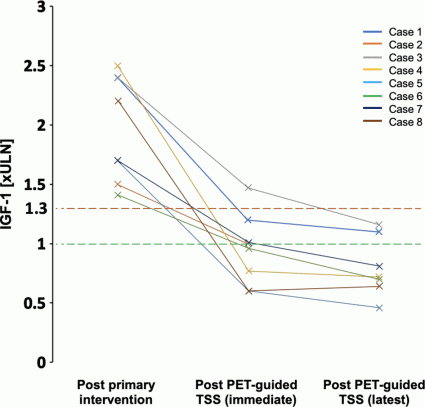SFEBES2019 ORAL POSTER PRESENTATIONS Neuroendocrinology, Pituitary and Neoplasia (4 abstracts)
Extended TSS (guided by 11C-methionine PET + MRI (Met-PET/MRCR)) can be an effective treatment option for patients with persistent acromegaly due to previously deemed unresectable lateral disease
Waiel A Bashari , Russell Senanayake , Antia Fernandez-Pombo , Daniel Gillett , Olympia Koulouri , Andrew Powlson , Heok Cheow , Iosif Mendichovszky , Angelos Kolias , James Tysome , Thomas Santarius , Richard Mannion & Mark Gurnell
Cambridge University Hospital, Cambridge, UK
Objective: To determine if an extended lateral approach to trans-sphenoidal surgery (TSS), guided by 11C-Methionine PET/CT co-registered with volumetric MRI (Met-PET/MRCR), can lead to remission in patients with persistent acromegaly due to post-operative lateral/para-sellar tumour remnants.
Methods: We identified eight patients with persistent acromegaly following primary intervention [TSS ± medical therapy ± radiotherapy (RT)], in whom further surgery had initially been discounted due to suspected unresectable lateral/para-sellar disease. All patients underwent Met-PET/MRICR. Scan findings were used by the pituitary multidisciplinary team to inform decision-making with regards to repeat surgery. Extended TSS was performed with wide lateral exploration as guided by the findings of Met-PET/MRICR.
Results: Met-PET/MRICR demonstrated lateral/parasellar tracer uptake in areas of suspected residual disease in all studied patients. Physiological uptake was also seen within the normal pituitary gland. At surgery, in five patients tumour was identified and resected, although histology confirmed somatotroph tumour in only four cases. In the other three patients, no definite tumour was seen, but scar tissue was removed. However, despite the uncertainty at surgery, all patients achieved significant post-operative clinical and biochemical improvement [Insulin like growth factor (IGF-1) < 1.2 ( the upper limit of normal (ULN) in all cases, and fully normalised in six patients], Figure 1. These findings were maintained for up to 28 months (mean follow up in all patients = 13 months). No patient suffered any additional pituitary deficit or other complication of surgery.

Figure 1 IGF-1 levels (expressed in relation to the ULN (upper limit of normal)) measured at three time-points. The ‘immediate’ post-PET-guided TSS timepoint was performed at 6-weeks whereas the latest measurement was performed at varying intervals, averaging at 13 months post-PETguided TSS.
Conclusion: PET-guided extended surgery may be an effective treatment in patients with persistent acromegaly due to lateral/parasellar disease.



